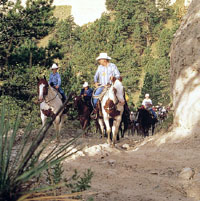
Riding on rocky, rough terrain or hard surfaces can invite injury if you’re not careful. The best way to protect your horse’s legs is to simply reduce the amount of time riding on hard surfaces–and to take it easy on your horse when you do. Save any work faster than a jog for prepared surfaces, such as arenas.
For a measure of protection during the time you do ride on hard or rocky terrain, consider having pads put under your horse’s shoes. Ask your farrier for a recommendation that will suit both your horse and your riding situation.
1. If you encounter leg swelling after a ride, use the following treatment regimen: Run cold water on your horse’s legs for 10 to 15 minutes, twice a day, until the swelling goes down.
2. After each cold-water session, apply a poultice, such as Uptite (Uptite Chemical Company) or Numatozine (Hobart Laboratories), to draw out the excess fluids. Cover the poultice with plastic wrap or brown paper (e.g., a cut-up grocery bag), then apply a standing wrap over all. (Note: if you’re unfamiliar with how to properly apply leg wraps, ask your vet to show you how, or apply the poultice to your horse’s legs and allow it to dry, uncovered.)
3. After much of the swelling has gone down, wrap your horse’s legs (again, only if you know how to do so properly) using stable bandages over heavy, pillowlike padding. This method will “massage” the remaining swelling out of the tissues.
Depending on the duration and/or severity of your horse’s swelling, it may also be beneficial to give him phenylbutazone (“bute”) to reduce inflammation, and a liniment rubdown to increase the blood flow to the affected areas. But you should first discuss your horse’s condition with your veterinarian.
Jim Morgan, DVM, an equine practitioner for some 30 years, devotes his practice primarily to the needs of performance Quarter Horses. He’s an accomplished horseman and reiner and resides in Pilot Point, Texas.
This article first appeared in the December 1997 issue of Horse & Rider magazine.






